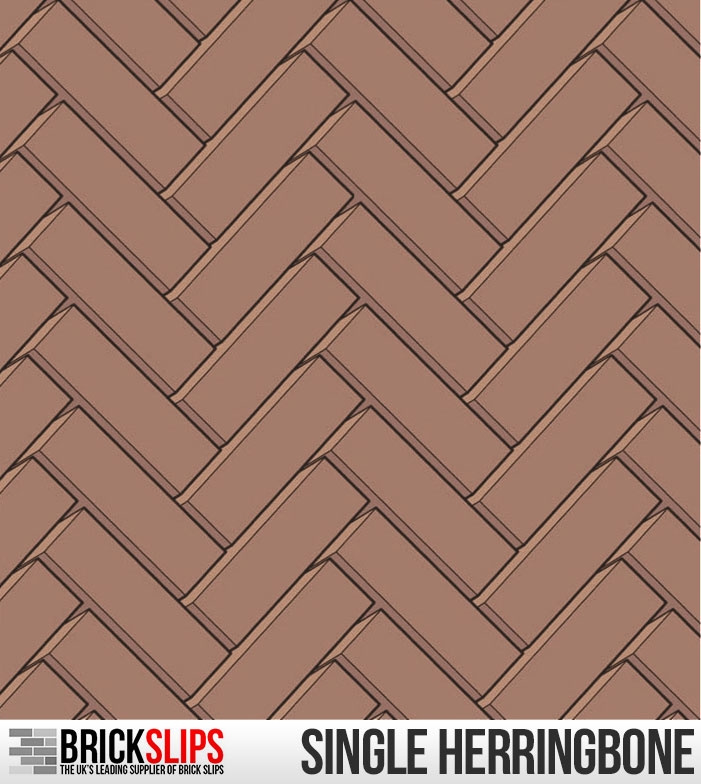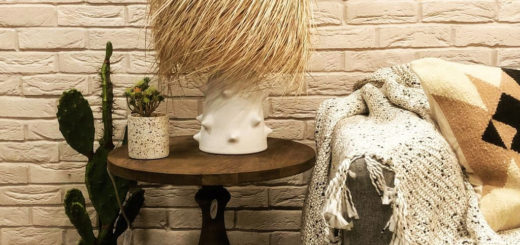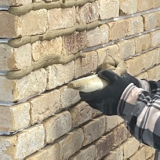Welcome to Ask Andy, the go to place for those questions that you might need the answers too.
Today’s special post looks at brick bond patterns:
What are Bond Patterns?
Brick Slip Stretcher Bond

This laying pattern is typically your standard brick wall formation that you’ll have seen previously on most brick buildings.
Our example image shows the use of 60 brick slips (two boxes) 1 meter square, in the Standard Strecher bond formation.
Brick Slip Horizontal Stackbond

This brick laying pattern bond is where the facing brick is laid with all vertical joints aligned. In brick veneer masonry this pattern constists of single slips which have been set with continuous vertical and horizontal joints to create a defined let very symertical formal laying pattern.
Our example image shows the use of 60 brick slips (two boxes) 1 meter square, in the Horizontal Stackbond formation.
Brick Slip Flemish Bond

The introduction of Flemish Bond Brickwork in the 17th century introduced not just strength, but a great aesthetic look to buildings. This bond was more often used on private buildings.
This pattern has header brick slips set between every standard brick slip. Each header is centrally located and placed between the standard brick slips. This tie is now rarely used in new, modern building and is more suitable for garden walling and feature structures. It can get a very difficult tie in this brick slips laying pattern because it requires a lot of attention to detail, however we feel it’s worth the effort for this vintage brick work look.
Our example image shows the use of 40 brick slips and 40 brick slip headers in 1 meter square, in this Flemish Bond formation.
Brick Slip Monk Bond

Monk bond creates a zigzag effect by having two stretchers and one header in the same course, with bricks forming the pattern at one and a half brick intervals.
The wall thickness is one brick. There are internal straight joints up to one and a half bricks in length in this wall.
Our example image shows the use of 48 brick slips and 24 brick slip headers in 1 meter square, in this Monk Bond formation.
Brick Slip English Bond

Histroy knows that the English bond is possibly the strongest brick bond as there are no straight joints in the wall. It is used for one brick thick walls. It consists of one course of stretchers followed by one course of headers. This is easily replicated in brick slips for a stunning feature brick effect.
Our example image shows the use of 30 brick slips and 60 brick slip headers in 1 meter square, in this English Bond formation.
Brick Slip English Garden Wall

English garden wall bond consists of three courses of stretchers to one of headers. Historically the walls thickness is one brick & there is an internal straight joint between the courses of stretchers which is replicated with the used of our brick slip headers.
Our example image shows the use of 50 brick slips and 18 brick slip headers in 1 meter square, in this English Garden Wall Bond formation.
Brick Slip Vertical Stackbond

The vertical stack bond is made up of courses of stretchers where each stretcher is stacked directly above a stretcher and the joints align. This is not a structural bond and is generally used on interiors for non-load bearing walls – The ultimate need for using brick slips.
Our example image shows the use of 48 brick slips and 24 brick slip headers in 1 meter square, in this Stackbond formation.
Brick Slip Basket Weave

The Basket weave is a purely decorative bond and it was mainly used in floor and wall panels. This is often popular in bathrooms and kitchens or even outside as garden feature walls.
Our example image shows the use of 60 brick slips in 1 meter square, in this Basket Weave Bond formation.
Brick Slip Single Herringbone

A Single Herringbone is a purely decorative bond It is used in floor and wall panels and widely used in other area’s.
Our example image shows the use of 60 brick slips in 1 meter square, in this Herringone Bond formation.
Brick Slip Double Herringbone

Like the previous, A DoubleHerringbone is a purely decorative bond It is used in floor and wall panels and widely used in other area’s however makes use of the double brick look over a single. There is no difference in brick slips used.
Our example image shows the use of 60 brick slips in 1 meter square, in this Double Herringbone Bond formation.
Why not Ask Andy!
If you’re in doubt then give Andy a shout in the comments box below!
Also, be sure to check back in here for future additions to our popular “Ask Andy” column.

































We’d like to use the horizontal stacked bond pattern on small kitchen extension. We’ve ordered samples liked the Victoria red but builder says sizes/width too uneven because won’t align with original brick wall he’d built for a 20mm thick brick but the sizes in sample vary. We want an old brick effect – which of you slips best suit this type of layout ie which are most regular 20mm tho k?
Hi Claudia,
You can use any of our brick slips for a horizontal stacker bond, It’s completely personal choice to which you choose. They’re all 20mm unless otherwise stated (Like the elite range, those are 14mm thick) I hope that helps!